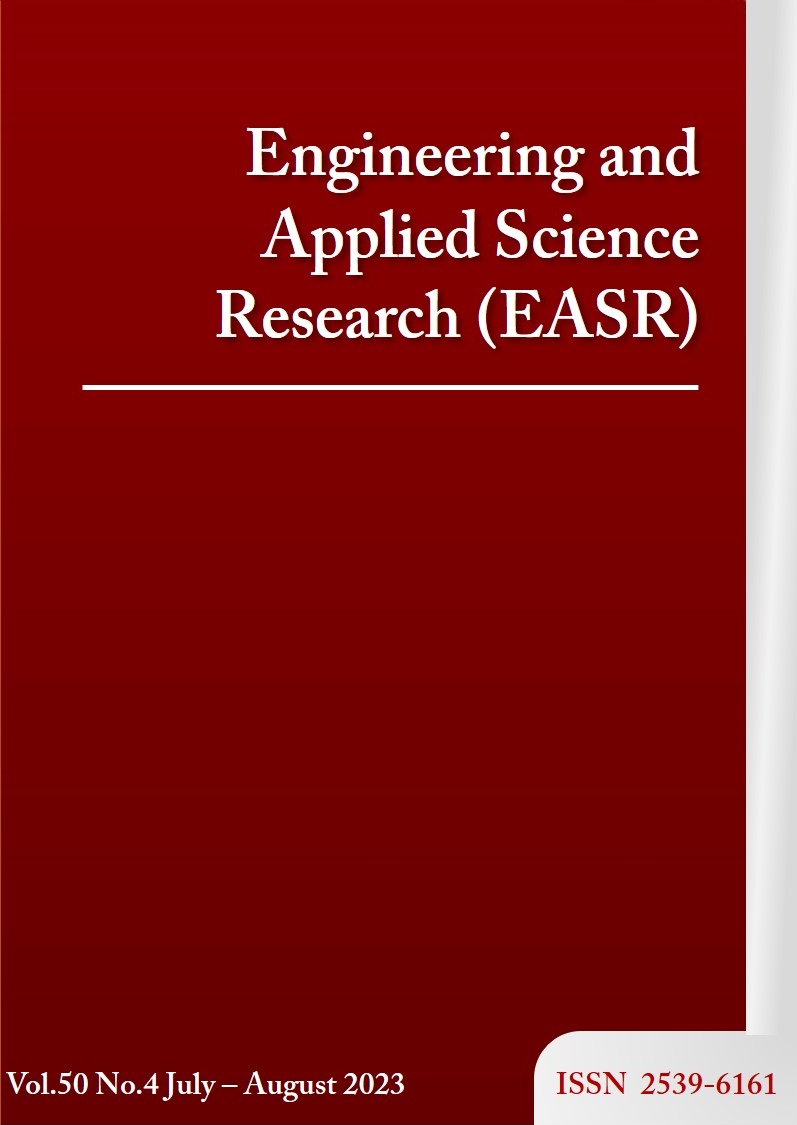Synthesis of epoxy oil from Waste Cooking Oil (WCO) using acetic acid and amberlite resin IR-120 as catalyst
Main Article Content
Abstract
Several reports showed that the high unsaturated fatty acids present in waste cooking oil (WCO) held significant potential as a valuable raw material for the production of epoxy oil. Therefore, this study aimed to develop a method for effectively utilizing WCO in the synthesis of epoxy oil with acetic acid and amberlite resin IR-20 as catalyst. The synthesis process involved the use of a reflux method at 60oC with various epoxidation times (4, 6, and 8 hours) on a batch scale. The materials used included hydrogen peroxide, glacial acetic acid (homogeneous catalyst), and amberlite resin IR-120 (heterogeneous catalyst) with different mass ratio of WCO to amberlite resin IR-120 (100:0; 100:1.58; 100:3.15; and 100:6.3). The functional group analysis results using the Fourier transform infrared (FTIR) spectrophotometer showed the presence of stretching vibrations of the epoxy group (C-O-C) at 850-830 cm-1 and 1240 cm-1. Increasing the ratio of WCO to amberlite resin IR-120 from 100:0 to 100:3.15 led to a decrease in iodine number and an increase in oxirane number. A further increase in the ratio to 100:6.3 provided an increase in the iodine number and a decrease in the oxirane number. Furthermore, the highest oxirane number was achieved with a 100:3.15 ratio of WCO to amberlite resin IR-120. Based on the results, an increment in the epoxidation time from 4 hours to 8 hours led to a decrease in the iodine number and an increase in the oxirane number. The highest oxirane number of 2.4159% was achieved with a 100:3.15 ratio of WCO to amberlite resin IR-120 for 8 hours.
Article Details

This work is licensed under a Creative Commons Attribution-NonCommercial-NoDerivatives 4.0 International License.
This work is licensed under a Creative Commons Attribution-NonCommercial-NoDerivatives 4.0 International License.
References
Sahar, Sadaf S, Iqbal J, Ullah I, Bhatti HN, Nouren S, et al. Biodiesel production from waste cooking oil: an efficient technique to convert waste into biodiesel. Sustain Cities Soc. 2018;41:220-6.
Moazeni F, Chen YC, Zhang G. Enzymatic transesterification for biodiesel production from used cooking oil, a review. J Clean Prod. 2019;216:117-28.
Panchal TM, Patel A, Chauhan DD, Thomas M, Patel JV. A methodological review on bio-lubricants from vegetable oil based resources. Renew Sustain Energy Rev. 2017;70:65-70.
Borugadda VB, Goud VV. Synthesis of waste cooking oil epoxide as a bio-lubricant base stock: characterization and optimization study. J Bioprocess Eng Biorefinery. 2014;3(1):57-72.
Bautista LF, Vicente G, Rodríguez R, Pacheco M. Optimisation of FAME production from waste cooking oil for biodiesel use. Biomass Bioenergy. 2009;33(5):862-72.
Murniati M, Gunawan ER, Suhendra D, Asnawati D, Qurba P. Synthesis of epoxy compounds from nyamplung oil fatty acids (Calophyllum inophyllum l.). J Ris Kim. 2022;13(1):89-99. (In Indonesia)
Kusdiana D, Saka S. Effects of water on biodiesel fuel production by supercritical methanol treatment. Bioresour Technol. 2004;91(3):289-95.
Pan S, Hou D, Chang J, Xu Z, Wang S, Yan S, et al. A potentially general approach to aliphatic ester-derived PVC plasticizers with suppressed migration as sustainable alternatives to DEHP. Green Chem. 2019;21(23):6430-40.
Khan AD, Alam MN. Cosmetics and their associated adverse effects: a review. J Appl Pharm Sci Res. 2019;2(1):1-6.
Bui TT, Giovanoulis G, Cousins AP, Magnér J, Cousins IT, de Wit CA. Human exposure, hazard and risk of alternative plasticizers to phthalate esters. Sci Total Environ. 2016;541:451-67.
Zhang Z, Jiang P, Liu D, Feng S, Zhang P, Wang Y, et al. Research progress of novel bio-based plasticizers and their applications in poly(vinyl chloride). J Mater Sci. 2021;56(17):10155-82.
Listiana Y, Tampubolon HR, Sinaga MS. Effect of catalyst concentration and reaction time to epoxy production from waste cooking oil. J Tek Kim USU. 2017;6(3):28-33. (In Indonesia)
Kurańska M, Beneš H, Prociak A, Trhlíková O, Walterová Z, Stochlińska W. Investigation of epoxidation of used cooking oils with homogeneous and heterogeneous catalysts. J Clean Prod. 2019;236:117615.
Rahmaniar, Priyanto G, Hamzah B. Rubber gompounding with epoxy gandlenut oil addition. Din Penelit BIPA. 2009;20(35):59-68. (In Indonesia)
Rahmaniar, Prasetya HA. Epoxy rubber seed oil as a softener agent for radiator seal production epoxided rubber seeds oil as a softener agent for radiator seals. J Ris Ind. 2011;V(1):71-8. (In Indonesia)
Campanella A, Fontanini C, Baltanás MA. High yield epoxidation of fatty acid methyl esters with performic acid generated in situ. Chem Eng J. 2008;144(3):466-75.
Salih A, Ahmad M, Ibrahim N, Dahlan K, Tajau R, Mahmood M, et al. Synthesis of radiation curable palm oil–based epoxy acrylate: nmr and ftir spectroscopic investigations. Molecules. 2015;20(8):14191-211.
Saha P, Kim BS. Preparation, characterization, and antioxidant activity of β-carotene impregnated polyurethane based on epoxidized soybean oil and malic acid. J Polym Environ. 2019;27(9):2001-16.
Zhang C, Ding R, Kessler MR. Reduction of epoxidized vegetable oils: a novel method to prepare bio-based polyols for polyurethanes. Macromol Rapid Commun. 2014;35(11):1068-74.
Sienkiewicz AM, Czub P. The unique activity of catalyst in the epoxidation of soybean oil and following reaction of epoxidized product with bisphenol A. Ind Crops Prod. 2016;83:755-73.
Cooney MT. Epoxidised resins from natural renewable resources [Dissertation]. Australia: University of Southern Queensland; 2009.
Lee PL, Wan Yunus WMZ, Yeong SK, Abdullah DK, Lim WH. Optimization of the epoxidation of methyl ester of palm fatty acid distillate. J Oil Palm Res. 2009;21:675-82.
Petrović ZS, Zlatanić A, Lava CC, Sinadinović-Fišer S. Epoxidation of soybean oil in toluene with peroxoacetic and peroxoformic acids-kinetics and side reactions. Eur J Lipid Sci Technol. 2002;104(5):293-9.
Saurabh T, Patnaik M, Bhagt SL, Renge VC. Epoxidation of vegetable oils: a review. Int J Adv Eng Technol. 2011;II(IV):491-501.
Sinaga MS. Effect of H2SO4 catalyst on the epoxidation reaction of PFAD methyl ester. J Teknol Proses. 2007;6(1):70-4. (In Indonesia)



